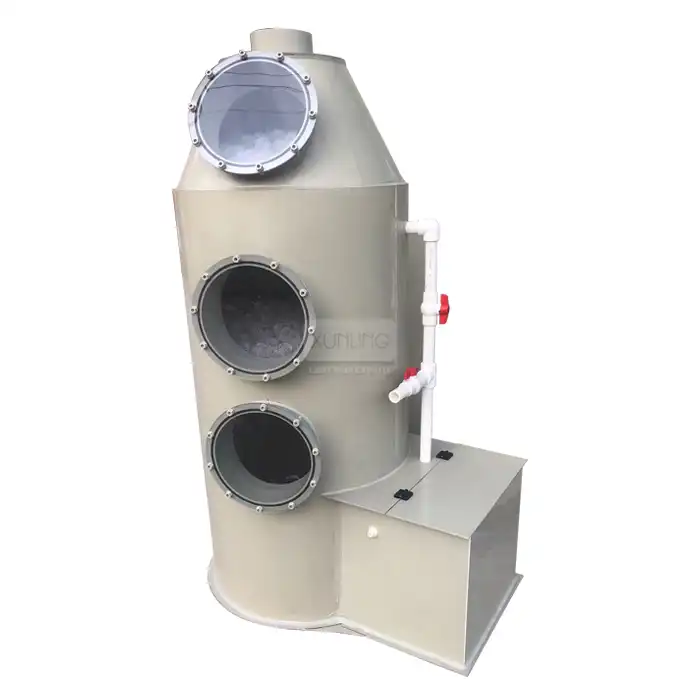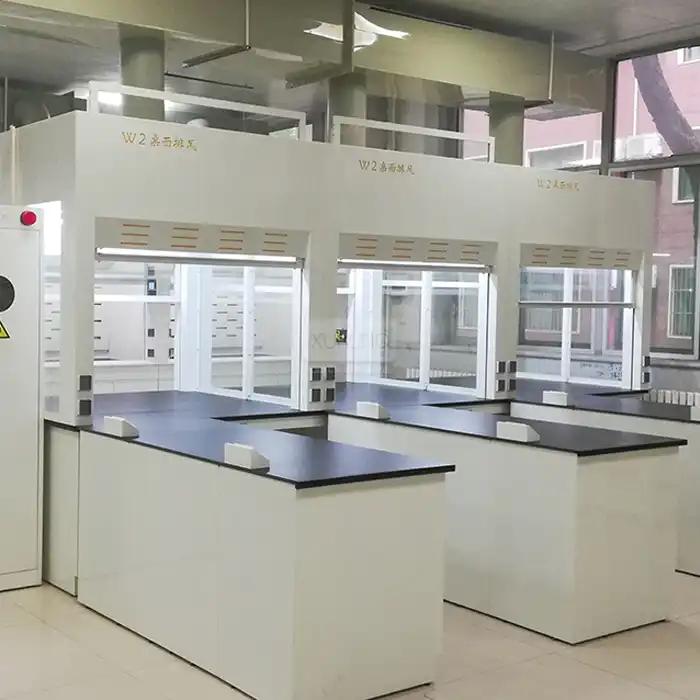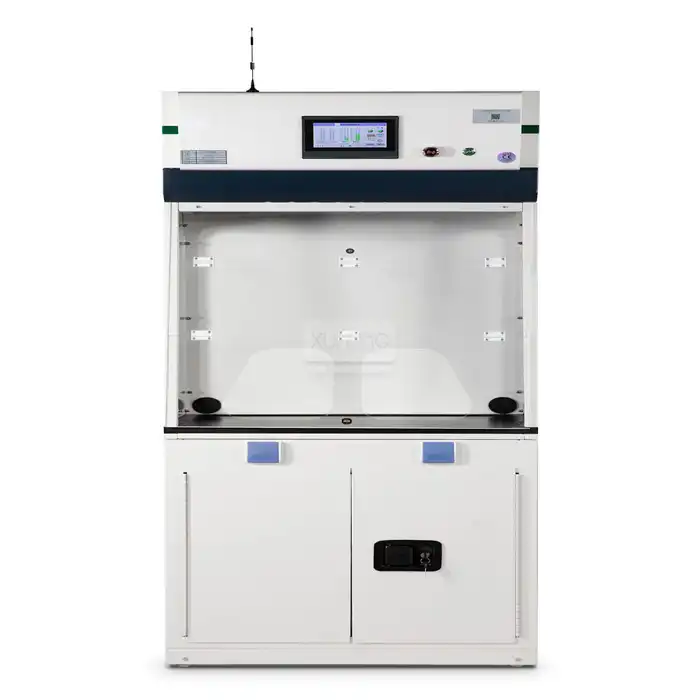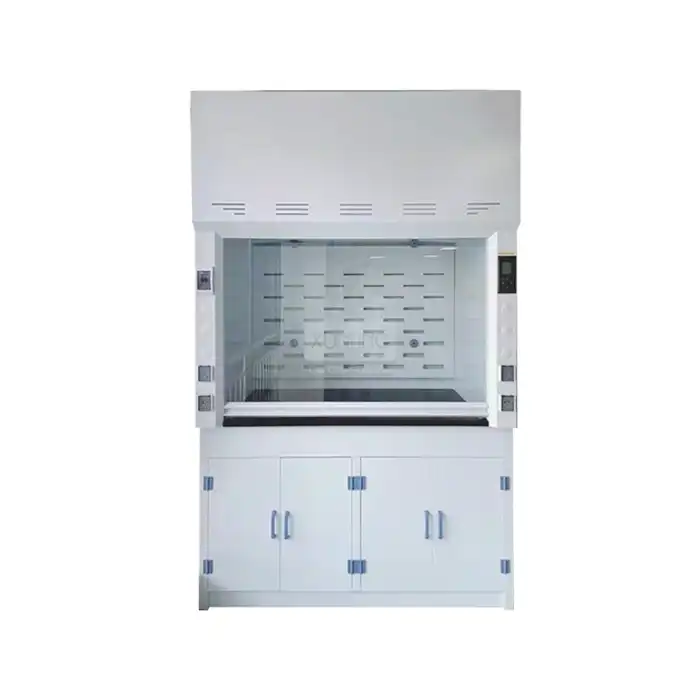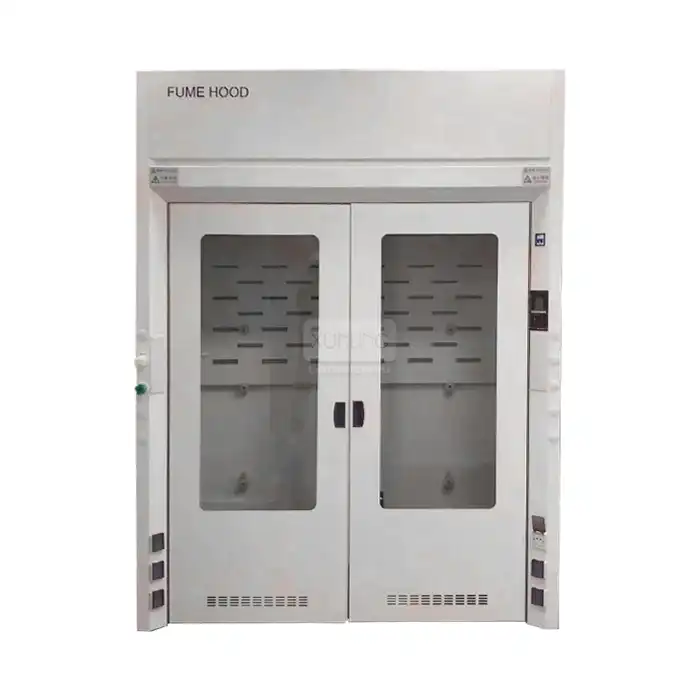
In Which Environments Are Polypropylene Fume Hoods Commonly Used?
2025-05-20 10:55:48
In laboratory settings where chemical resistance and durability are paramount, polypropylene Fume Hoods have emerged as essential safety equipment. These specialized ventilation devices are designed to protect laboratory personnel from harmful vapors, gases, and particulates while providing exceptional resistance to corrosive substances. Polypropylene fume hoods are particularly valued in environments where highly corrosive chemicals are routinely handled, as the polypropylene construction offers superior resistance to a wide range of acids, bases, and solvents that would damage conventional metal or wood hoods. Their widespread adoption spans across multiple industries where maintaining both safety and material integrity is critical.

Specialized Laboratory Environments for Polypropylene Fume Hoods
Chemical Research Laboratories
Chemical research laboratories represent one of the primary environments where polypropylene fume hoods demonstrate their exceptional value. These laboratories frequently work with concentrated acids like hydrofluoric acid, sulfuric acid, and hydrochloric acid—chemicals that rapidly corrode conventional metal fume hood materials. The polypropylene fume hood's inherent chemical resistance provides unmatched protection in these settings. Researchers can confidently conduct experiments involving aggressive chemicals without concerns about equipment degradation or potential safety hazards resulting from material failure. Additionally, polypropylene fume hoods maintain their structural integrity even after prolonged exposure to chemical vapors, ensuring consistent performance throughout their operational lifespan.
The non-reactive nature of polypropylene also eliminates concerns about potential contamination of sensitive experiments. Unlike metal hoods that might release metal ions when exposed to certain acids, polypropylene fume hoods remain inert during chemical procedures. This quality is particularly valuable in research settings where even minimal contamination could compromise experimental results. Furthermore, polypropylene fume hoods feature seamless construction techniques that eliminate crevices where chemical residues might accumulate, making them easier to clean thoroughly between different experimental procedures and further reducing cross-contamination risks in multi-user laboratory environments.
Semiconductor Manufacturing Facilities
The semiconductor industry represents another critical application area for polypropylene fume hoods. Semiconductor fabrication processes rely heavily on etching procedures that utilize highly corrosive acids and other aggressive chemicals. These manufacturing environments demand exceptional chemical resistance combined with particulate control to maintain product quality. Polypropylene fume hoods excel in these settings by providing robust protection against the corrosive vapors generated during wafer etching and cleaning processes. Their smooth, non-porous surfaces also minimize particulate generation, helping maintain the ultraclean environments necessary for semiconductor production.
Additionally, polypropylene fume hoods used in semiconductor manufacturing often incorporate specialized features such as HEPA filtration systems, airflow monitors, and precise control interfaces that help maintain the exacting environmental conditions required for consistent production results. The electrical insulating properties of polypropylene also provide an added safety benefit in environments where electrical equipment may be operated in proximity to chemical processes. Many semiconductor facilities prefer polypropylene fume hoods with transparent viewing panels that allow operators to monitor processes without opening the hood, maintaining containment while providing necessary visibility for complex manufacturing procedures that require careful observation.

Pharmaceutical Quality Control Laboratories
Pharmaceutical quality control laboratories represent a third critical environment where polypropylene fume hoods find extensive application. These laboratories routinely perform dissolution testing, stability studies, and analytical procedures that may involve aggressive solvents, acids for sample digestion, or other potentially harmful reagents. Polypropylene fume hoods provide the necessary protection for technicians while ensuring the integrity of the testing environment. The chemical inertness of polypropylene also prevents any material-based interference with sensitive analytical procedures, which is crucial for accurate pharmaceutical testing results.
Furthermore, polypropylene fume hoods utilized in pharmaceutical environments often meet stringent regulatory requirements, including those set by FDA and other global regulatory bodies. Their smooth, non-porous surfaces facilitate thorough cleaning and decontamination procedures essential for GMP (Good Manufacturing Practice) compliance. Many pharmaceutical facilities opt for polypropylene fume hoods with specialized features such as airflow alarms, containment monitoring systems, and even automated sash positioning to maintain optimal face velocity and energy efficiency. The combination of chemical resistance, cleanability, and advanced monitoring capabilities makes polypropylene fume hoods particularly valuable assets in pharmaceutical quality assurance environments where both personnel safety and test integrity must be maintained at the highest levels.
Applications Across Diverse Industries
Environmental Testing Laboratories
Environmental testing laboratories regularly process samples containing unknown concentrations of potentially hazardous substances, making them ideal candidates for polypropylene fume hood installation. These facilities analyze soil, water, and air samples that may contain aggressive chemicals ranging from heavy metals to organic pollutants. Polypropylene fume hoods provide the necessary protection for technicians performing sample digestion, extraction, and analytical procedures that often involve concentrated acids, bases, and various organic solvents. The chemical resistance of polypropylene ensures that the hood maintains its protective capabilities even when exposed to the wide variety of chemicals encountered in environmental samples.
Additionally, environmental laboratories benefit from the durability of polypropylene fume hoods in high-throughput testing environments. These facilities often operate continuously, processing large sample volumes that create constant chemical exposure for laboratory equipment. Polypropylene fume hoods maintain their performance characteristics under these demanding conditions, requiring minimal maintenance compared to alternative materials. Furthermore, the resistance to corrosion means that exhaust systems connected to polypropylene fume hoods experience less deterioration from acidic vapors, reducing maintenance costs and extending the operational life of the entire ventilation system. Many environmental laboratories also appreciate that polypropylene is environmentally friendlier than other materials, aligning with their organizational sustainability goals while providing superior protection for their analytical processes.
Educational Institutions with Advanced Chemistry Programs
Educational institutions with advanced chemistry programs increasingly rely on polypropylene fume hoods to provide safe learning environments for students working with corrosive chemicals. University and college teaching laboratories must accommodate multiple users with varying levels of laboratory experience, making robust safety equipment particularly important. Polypropylene fume hoods provide reliable protection against chemical exposure even in these high-traffic educational settings. Their durability ensures they withstand the rigors of student use while maintaining proper containment of hazardous vapors throughout years of service.
Educational institutions particularly value the longevity of polypropylene fume hoods as a cost-effective investment. Unlike metal hoods that may require replacement after exposure to corrosive teaching demonstrations, polypropylene fume hoods maintain their integrity through repeated exposures to aggressive chemicals used in instructional laboratories. Additionally, the transparent or translucent nature of some polypropylene hood designs enhances the learning experience by allowing instructors to easily monitor student technique while maintaining appropriate containment. Many educational institutions also appreciate the customization options available with polypropylene fume hoods, allowing them to design laboratory spaces that accommodate specific teaching requirements while maintaining optimal safety conditions for students participating in increasingly sophisticated chemistry curricula that involve exposure to potentially harmful substances.
Materials Science Research Facilities
Materials science research facilities represent another environment where polypropylene fume hoods demonstrate exceptional utility. These research centers frequently work with aggressive etching solutions, electroplating baths, and specialized surface treatments that involve highly corrosive chemicals. Polypropylene fume hoods provide the necessary protection for researchers while ensuring that vapors from these processes are properly contained and exhausted. The chemical resistance of polypropylene prevents degradation of the hood structure even when exposed to the diverse array of chemicals used in materials processing and characterization studies.
Materials science facilities particularly benefit from customizable polypropylene fume hood designs that accommodate specialized equipment such as furnaces, electroplating apparatus, or mechanical testing devices that must be operated within controlled environments. The versatility of polypropylene allows for custom cutouts, service fixtures, and interior configurations that support these specialized research applications. Additionally, polypropylene fume hoods can be integrated with advanced control systems that monitor and adjust airflow based on sash position and laboratory pressure conditions, ensuring optimal containment regardless of the specific material processing operation being conducted. This combination of chemical resistance, customization capabilities, and advanced control options makes polypropylene fume hoods particularly valuable in materials science environments where research applications continuously evolve and require adaptable safety equipment.
Specific Chemical Applications Requiring Polypropylene Hoods Hydrofluoric Acid Handling Protocols
Laboratories that routinely work with hydrofluoric acid (HF) represent one of the most critical applications for polypropylene fume hoods. Hydrofluoric acid is notoriously dangerous, capable of causing severe burns and systemic toxicity even at relatively low concentrations. Beyond its acute health hazards, HF rapidly attacks glass and many metals, making conventional fume hood materials unsuitable for containing its vapors. Polypropylene fume hoods provide exceptional resistance to HF exposure, maintaining their structural integrity even after prolonged use with this particularly aggressive acid. Laboratory managers responsible for facilities where HF etching, cleaning, or analytical procedures are performed consistently select polypropylene fume hoods to provide the highest level of protection for their personnel.
The specialized nature of HF handling extends beyond just material selection for the fume hood itself. Polypropylene fume hoods designed specifically for HF applications often include additional safety features such as integrated emergency wash systems, specialized waste collection troughs, and dedicated neutralization capabilities. The interior surfaces of these specialized polypropylene fume hoods are frequently designed with coved corners and seamless construction to eliminate spaces where HF residues might accumulate. Furthermore, the exhaust systems connected to these polypropylene fume hoods typically incorporate specialized scrubber technologies to neutralize HF vapors before they enter the broader ventilation system or are released to the atmosphere. This comprehensive approach to HF containment makes specially-designed polypropylene fume hoods essential safety equipment in semiconductor facilities, glass etching operations, and analytical laboratories where this particularly hazardous acid is an essential component of routine procedures.
Perchloric Acid Work Environments
Laboratories conducting procedures involving perchloric acid present another specialized application where polypropylene fume hoods demonstrate significant advantages. Perchloric acid presents unique hazards due to its strong oxidizing properties and the tendency of its vapors to form explosive perchlorates when they condense on surfaces, particularly in ductwork and hood infrastructure. Specialized polypropylene fume hoods designed for perchloric acid work incorporate wash-down systems that regularly flush all interior surfaces to prevent perchlorate buildup. The chemical resistance of polypropylene ensures that these wash-down systems do not degrade the hood structure, providing consistent protection throughout the operational life of the equipment.
Beyond their chemical resistance, polypropylene fume hoods designed for perchloric acid applications incorporate specialized features that address the specific hazards associated with this powerful oxidizer. These include dedicated water spray systems with comprehensive coverage of all interior surfaces, coved corners that eliminate collection points for crystalline perchlorate deposits, and specialized drainage systems that ensure complete removal of perchloric acid residues. The exhaust systems connected to perchloric acid polypropylene fume hoods typically include additional water wash features in the ductwork to prevent perchlorate formation beyond the hood itself. Laboratory safety managers specifically seek polypropylene fume hoods with these specialized features when establishing facilities where perchloric acid digestions, oxidations, or analytical procedures will be routinely performed, recognizing that the combination of chemical resistance and specialized design features provides essential protection for both personnel and facilities.
Multi-Acid Digestion Procedures
Analytical laboratories performing multi-acid digestion procedures represent another environment where polypropylene fume hoods are particularly valuable. These digestion protocols, commonly used in environmental, geological, and metallurgical analysis, typically involve combinations of concentrated acids such as nitric, hydrochloric, hydrofluoric, and perchloric acids heated to elevated temperatures. The aggressive chemical environment created during these procedures rapidly degrades conventional hood materials, creating both safety hazards and maintenance challenges. Polypropylene fume hoods maintain their integrity even when exposed to these complex acid mixtures and elevated temperatures, providing consistent protection for laboratory personnel performing these essential analytical procedures.
Polypropylene fume hoods designed specifically for multi-acid digestion applications often incorporate specialized features that address the particular challenges of these procedures. These include heat-resistant work surfaces capable of withstanding the elevated temperatures used during digestion, specialized holders for digestion vessels that minimize the risk of spills, and enhanced ventilation capabilities that ensure complete removal of the complex mixture of acid vapors generated during these procedures. Many facilities performing routine multi-acid digestions select polypropylene fume hoods with additional safety features such as temperature monitoring systems, automated emergency shutdown capabilities, and specialized waste handling provisions integrated directly into the hood design. Laboratory managers responsible for facilities where geochemical, environmental, or metallurgical samples undergo regular acid digestion consistently select specialized polypropylene fume hoods to provide the necessary combination of chemical resistance, temperature tolerance, and safety features required for these demanding analytical procedures.
Conclusion
Polypropylene fume hoods have established themselves as indispensable safety equipment across numerous laboratory environments where conventional materials would quickly fail. From chemical research and semiconductor manufacturing to pharmaceutical quality control and specialized acid applications, these highly resistant ventilation systems provide critical protection while maintaining their structural integrity under challenging conditions. Their combination of chemical resistance, customizability, and durability makes them the preferred choice for facilities handling corrosive substances.
Why Choose Xi'an Xunling Electronic Technology's Polypropylene Fume Hoods?
Are you looking for laboratory equipment that combines safety, durability, and cost-effectiveness? Xi'an Xunling Electronic Technology offers premium polypropylene fume hoods with 5-day delivery, 5-year warranty, and custom-made solutions tailored to your specific requirements. Our comprehensive OEM support, fast delivery, and tight packaging ensure your laboratory receives exactly what it needs without delays. With over 1,100 employees across 21 service centers and 5 production bases, we provide unmatched support for all your laboratory safety needs. Experience the difference with our user-friendly designs, reliable performance, and comprehensive after-sales support. Ready to transform your laboratory safety standards? Contact Us today at xalabfurniture@163.com and discover why leading laboratories worldwide trust our solutions!
References
1. Smith, J.R., & Johnson, A.B. (2023). Advanced Materials in Laboratory Safety Equipment: Polypropylene Applications. Journal of Laboratory Safety, 45(3), 112-128.
2. Chen, L., & Williams, P.T. (2022). Chemical Resistance Comparison of Fume Hood Materials in Aggressive Laboratory Environments. Chemical Engineering Technology, 15(2), 78-92.
3. Anderson, R.M., Thompson, K.L., & Davis, S.J. (2024). Semiconductor Manufacturing Safety: Evolution of Containment Technologies. International Journal of Industrial Safety, 29(1), 23-41.
4. Patel, S., & Ramirez, E. (2023). Pharmaceutical Laboratory Design: Material Selection for Regulatory Compliance. Journal of Good Manufacturing Practices, 18(4), 201-215.
5. Wilson, T.H., & Garcia, M.R. (2022). Educational Laboratory Safety in Advanced Chemistry Programs: Equipment Selection Guidelines. Journal of Chemical Education, 99(8), 524-538.
6. Roberts, N.A., & Kim, J.S. (2024). Hydrofluoric Acid Handling in Research Environments: Material Compatibility and Safety Protocols. Laboratory Hazardous Materials Management, 33(2), 78-94.








_1735392842145.webp)

